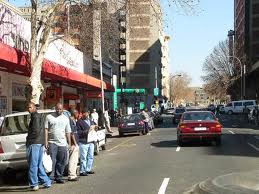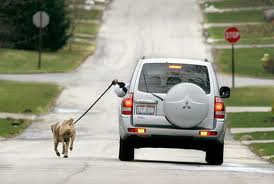CITY STREETS A SIGN OF OUR HUMANITY
As I threaded my motorbike through Johannesburg’s streets at dusk, the clumsy and careless driving that seems integral to city life everywhere, was eclipsed by a single act.
 I revved the throaty motor to warn wayward pedestrians before charging down the busy street with increasing speed. Ahead, a man with a heavy limp broke into a loping run to get out of the way, and as he ran to the median for safety, he turned to look at me, pointing urgently to a giant pothole ahead, warding me away from it.
I revved the throaty motor to warn wayward pedestrians before charging down the busy street with increasing speed. Ahead, a man with a heavy limp broke into a loping run to get out of the way, and as he ran to the median for safety, he turned to look at me, pointing urgently to a giant pothole ahead, warding me away from it.
It was a split-second gesture of bewildering selflessness. But perhaps it should have come as no surprise: South Africans have had to think of others in a way that few of us can imagine. How people long divided by class, race and heart-rending history can show such empathy makes me wonder whether the rest of us are doing all we can to make cities the best they can be.
Nowhere are people’s manners, mood and mentality more readily on display than on our streets, where a honk of the horn can be short, sharp and pre-emptive, or long, loud and self-righteous.
BACK (WARDS) IN CANADA…
Leaving Toronto for South Africa, I sat in the back of a cab that stopped at a red light. A pedestrian crossed to our side of the road pointing indignantly to the white line that we had overshot by a few centimetres. Needless to say he wasn’t trying to safeguard his safety, it was the wag of a finger I’ve seen on countless occasions by motorists, pedestrians and cyclists alike. And it sums up a big part of public life in Canadian cities in the 21st century: sanctimonious and self-centred.
 North American motorists are a breed apart. In spite of the car causing health problems, congestion and carbon emissions, few question or criticise excessive automobile use. But faced with the same pollution and worsening traffic conditions, other countries are reacting with an enviable sense of urgency.
North American motorists are a breed apart. In spite of the car causing health problems, congestion and carbon emissions, few question or criticise excessive automobile use. But faced with the same pollution and worsening traffic conditions, other countries are reacting with an enviable sense of urgency.
Mexico City was once so full of smog that breathing its air was once like smoking a pack of cigarettes. Polluting factories have since been shut down or forced to clean up, and cars are checked for emissions. Every Sunday, roads in the city centre are roped off for bikes and pedestrians.
London’s congestion charge and rise in the number of buses has reduced traffic in a city once almost paralysed by gridlock.
Parisian politicians legislated parts of the capital out of bounds for encroaching cars, built bike lanes and introduced bike rentals. Pollution levels are down.
Milwaukee recently expanded its bike lane network – and tripled bike ridership.
ALL OVER THE WORLD, PEOPLE ARE STARTING TO CLEAR UP THE CHAOS CREATED BY CARS.
Not so in Toronto though, where politicians voted against so much as a pilot project for bike lanes on University Avenue – one of the widest streets in the city.
The character of a society and its leaders – in business, politics and the social sectors – makes or breaks efforts at producing serious change , as we have seen from the 18th century’s industrial revolution in Britain, through to the 20th century information revolution in Sillicon Valley.
At the core of both were a spirit of hard work, inventiveness and daring. It’s what is making China and Germany world leaders in renewable energy. It helped South Africa put on a wildly successful World Cup.
In Canada, the privileges of the incessantly seated have so far trumped clear thinking. Our sprawling, congested cities and slow-moving vehicles make Canada one of the world’s top 10 emitters of CO2. Yet few politicians can countenance any alternative to the automobile.
HICK TOWN IN SHEEP’S CLOTHING
Toronto has just elected as mayor a man who not only discouraged the cleanest alternative yet to driving, he said it should be off the road. What’s more, cyclists who die in the street, said then councillor Rob Ford, have only themselves to blame: “My heart bleeds for them. But at the end of the day, it’s their own fault,” he told City Council a few years ago.
Even more disturbing than his unique brand of barbarism, is the sheer number of voters who marched to the polls thinking, “he has the vision we need to lead our city!”
Ford and his supporters seem oblivious to the fact that motorists who do get out of their cars and onto bikes and public transport, make room for drivers who have no alternative. The fewer cars that remain on the road, the more quickly motorists – and everyone else – will move around.
WAR ON EVERYONE BUT DRIVERS
Motorists, politicians and columnists have lamented a mythical “War on Cars,” and say the belated building of 100kms of bike lanes – alongside some 5,000 kms each of road and sidewalk – is a major cause of the city’s congestion.
In reality, cyclists squeeze by on the edge of the road, around broken glass and potholes, hoping not to be bumped off by a driver sending a text message. Public transit is busting at the seams, and can’t keep up with the population it’s supposed to serve. And with more cars crowding the roads every year, drivers sit in traffic jams of their own making, and scrape about for a scapegoat.
Toronto’s roads are like an over-booked aeroplane, so packed that late-arrivals are shunted to the luggage hold. The hefty ‘two-seater’ passengers complain the human cargo are adding weight to the plane and will slow down the flight.
The smiling Canadian crew seems oblivious to the turbulence ahead: smog, emissions and unchanging behaviour, where commuters drive to run errands two or three kms away.
Motorists need to rise up out of their worn seats, and take a fresh look around. They might just see the large, looming pothole ahead.

